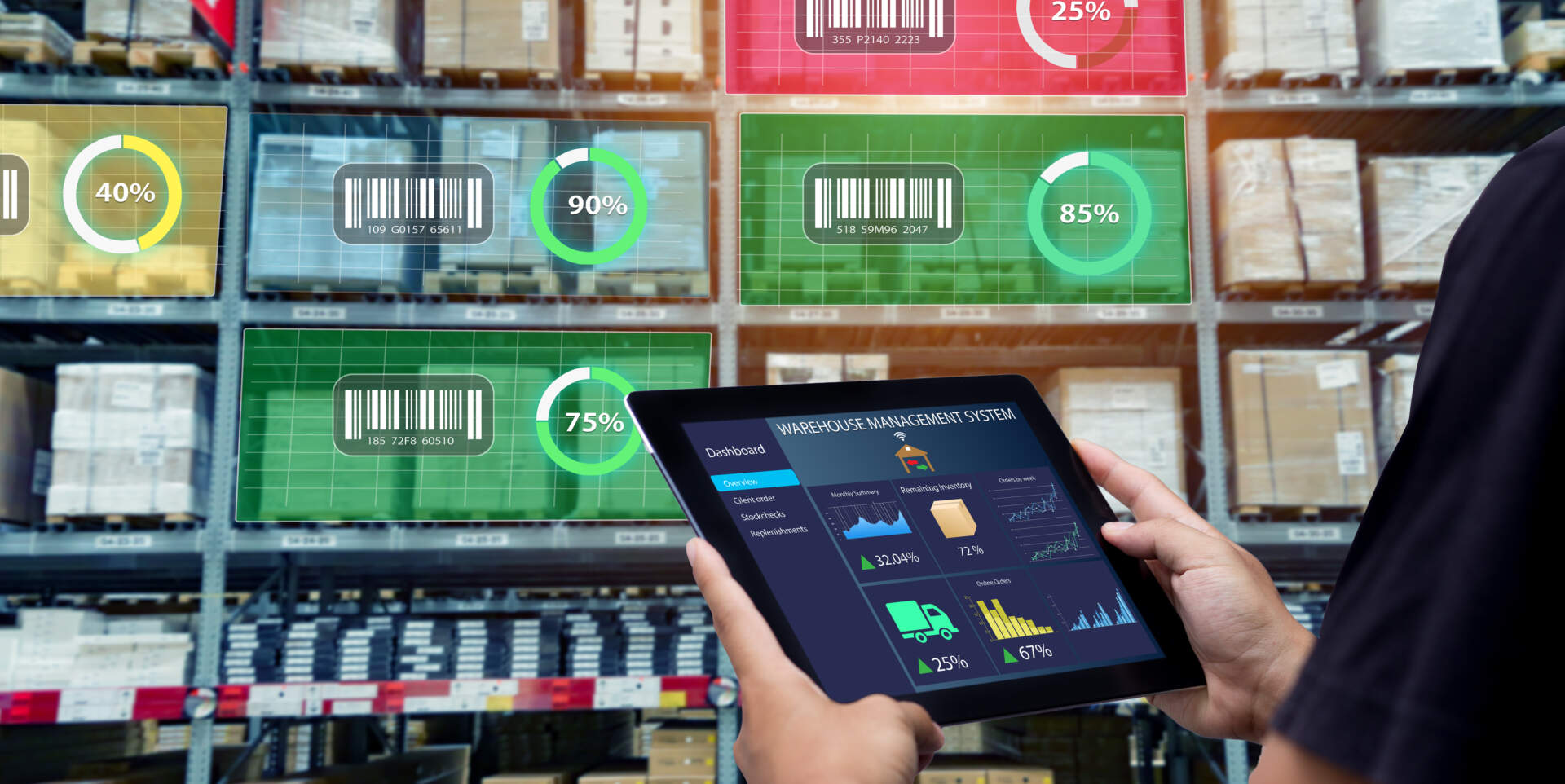
In 2023 logistics customers will be focused on using data to take better control of their businesses. Third party logistics (3PL) companies are increasingly ditching the tools of the past and bringing their processes up to speed. Telephone calls and paperwork are on the way out. Even emails are feeling a bit 2022. In their place? Customer-facing portals and systems. The result will be a plethora of information at the customers’ fingertips, enabling better and more timely business decisions.
From dock appointments to warehouse management, intuitive software is eliminating many of the pain points felt in supply chain management, allowing for better management of the process. You’ve got questions that need timely and accurate answers. In 2023, that’s what you should expect.
The 4 Cs of Logistics in 2023
How can technological upgrades throughout the logistics system provide real world benefits to you, the customer? The answer can be summarized into four Cs.
Control: More interface means an increased ability to secure the services you need, when you need them.
Clarity: WMS systems and other portals provide real time tracking and other valuable data, eliminating the need for guesswork and allowing for better decision making.
Confidence: Automated systems reduce the opportunity for human error. With all aspects of the supply chain journey documented, 3PL companies and their clients can sleep more easily.
Convenience: If voluminous email chains and spirited games of phone tag aren’t your bag, you’re in luck. While these options will remain, new systems allow for one-stop data entry that saves time on both ends of the company/customer relationship.
Answering 3 Big Questions That Keep Logistics Customers Up at Night
Information about your product is not nice-to-have, it’s must-have! Other aspects of your business are affected. Knowledge is power. Technological evolution in 3PL will ultimately provide quicker, better answers to three big questions.
1.Where the Heck is My Product?
Warehouse Management Systems
Customer-facing management systems are in place across many industries and the time has come for them to be the standard in logistics. The interactive systems allow 3PL customers to check inventory, create transactions, track orders, and access receipts.
Canadian Alliance is currently rolling out a new and improved WMS system to better serve their clients, as well as themselves.
The first benefit comes in the form of streamlined data collection.
“How much time have we spent in the past opening email attachments and typing everything up?” asks CA Director of Operations Vincent Wong somewhat rhetorically. “Now the customer sends an order and boom, I go into the WMS, push a button, and feed the information to the floor so they can begin picking or receiving.”
The innovation saves the company both labour and time, allowing them to remain price competitive. “The client isn’t waiting around while the order is keyed in,” adds Wong.
These clients not only benefit from easily accessed data, but increased accuracy.
“Our old system was programmed in such a way that when a warehouse associate picked up a pallet from racking, it was considered complete,” explains Wong. “If a delay was experienced in the staging area, it wouldn’t be noted.”
By comparison, the new system uses barcodes and virtual gates to provide real time information about the exact whereabouts of a pallet.
“There’s an actual barcode that we added to each of our overhead doors, representing the threshold of the door,” notes Wong. “As you load a pallet into a truck, you’re scanning that barcode to denote that it has physically crossed that threshold.”
That information is then instantly available through the WMS.
Canadian Alliance is rolling out the new program on a customer by customer basis, ensuring that proper onboarding and support are provided to customers.
“It’s an intuitive process for the client,” says Wong. “There’s no extra work on their end.”
2. How, Exactly, is My Product Getting from Point A to Point B?
In addition to the WMS system, several new tools are being utilized to help clients better control and manage their logistics. The result is decreased man-hours and increased customer confidence.
Management Portals for Dock Appointments
To say that there’s a lot of coming and going at docks and warehouses would be an understatement. Scheduling these by telephone or email invites errors and induces yawning. An appointment management portal makes much better sense.
Canadian Alliance has made the switch to the Smart Dock system, which allows clients to book dock appointments by viewing a calendar, choosing a convenient time, and filling out a short form.
“The Smart Dock system is already used by more than 3,000 warehouses in North America,” says Project Systems Manager Seyed Behnejad, noting that carriers who already utilize the system can use their existing credentials. “Most of the carriers are already familiar with how it works,” says Behnejad.
As was the case with the WMS, the Smart Dock System provides confidence by reducing error.
“Previously, when a customer wanted to book a dock appointment for inbound or outbound shipping they had to send an email,” explains Wong. Pertinent information would often be included at the bottom of lengthy emails on other topics, and could be difficult to locate when needed.
“Not only are emails tedious, but they provide an opportunity for mistakes or misinformation,” says Behnejad. “The process is much quicker this way.”
The Smart Dock system is an online, cloud-based web app which prompts those booking an appointment to include container numbers, reference numbers, and other necessary information. “With emails, this data was not always included,” recalls Wong.
Behnejad summarizes the benefits: “It’s streamlined, it’s faster, it’s more efficient, and it’s more secure.”
Transport Management Systems
Customer-facing transportation management systems put even more control in the hands of the client, allowing them to upload information while tracking the whereabouts of their shipment throughout the process. With just a few clicks, customers will learn the whereabouts of their product, allowing them to plan accordingly.
Canadian Alliance’s new TMS is intuitive to learn and use. In addition to providing real time data on shipments, the system can provide valuable financial information.
“As the customer creates a transaction or request in our system, they can run rates and immediately receive an estimate,” explains Behnejad. “They don’t need to wait for someone to do that for them.”
Electronic Bills of Lading
Paper bills of lading have been commonplace, but they don’t exactly inspire the imagination. The technology has long existed to modernize the process and 3PL companies, including Canadian Alliance, are increasingly doing so.
“Our electronic bill of lading will capture an electronic signature, which will be sent to the driver automatically,” says Behnejad. Once again, convenience is up and confusion is down. “We’ll be avoiding a lot of back and forth emails and missing paperwork,” explains Behnejad. “This will benefit the customer as well as the carrier.”
3. Who’s Touching My Product, AKA, What’s Going On Over There?
Cargo doesn’t move itself. From warehouse workers to truckers, there are a lot of hands involved in the supply chain process. Technology is increasingly being used to coordinate their efforts, while keeping the clients in the loop.
Labour Management Systems
A properly functioning labour management system increases clarity, coordination, and productivity within the facility. Essentially it enables the left hand to know what the right hand is doing.
“Our system gives us the ability to track all scannable movement within the warehouse,” notes Behnejad. “It shows us how much product we’re putting in the warehouse for each client, how long it takes to work on operations for that account, and what improvements we can bring to the system.”
As Wong explains, the enhanced capabilities allow for better employee tracking and, thus, monetary incentivization for productivity. “Each time a warehouse associate picks a product, they’re scanning a barcode. An algorithm allows us to track movements and score productivity.”
Not only does the system enhance efficiency, but boosts workplace morale. “One of the most important things for employee satisfaction is knowing what expectations are and how to achieve them,” notes Wong.
Self Service Driver Check In Kiosks
Ordering a Big Mac is now an automated interactive experience. Why, then, does chaos and confusion too often reign supreme at the loading dock?
To combat this, Canadian Alliance has introduced self service driver check-in kiosks at their warehouse.
“It’s not unlike the experience you have ordering food at McDonalds,” explains Behnejad. “Drivers are able to check in and enter their reference number and company name. The screen then prompts them to a certain dock door. It’s a better experience for the driver.”
English is a second language for many drivers, which is something the CA system takes into account.
“Our self-serve kiosk is also available in Punjabi, Chinese, Mandarin, and Hindi” says Wong, who adds that more languages may be added in the future. “This makes the system more efficient and accurate.”
The result of the kiosk is a time saving for both the warehouse and the driver.
“It allows us to retrieve an order quickly and get the driver set up, ready, loaded, and departed in the shortest amount of time possible,” says Wong.
Control is Key
Looking to the future, control is the name of the game. Analytics and data drive decision making, but are only feasible if information is readily available.
Many of the aforementioned technologies mirror systems that have already become commonplace in daily life. With so many moving parts impacting supply chain management, the time has come for such systems to graduate from value-added features to expectations.
Smooth transition is essential, which is why Canadian Alliance provides education and support to all customers implementing these systems. The ultimate result will be better customer service, increased customer confidence, and superior information.
Cited Sources
Personal Communications with Vincent Wong and Seyed Behnejad.
